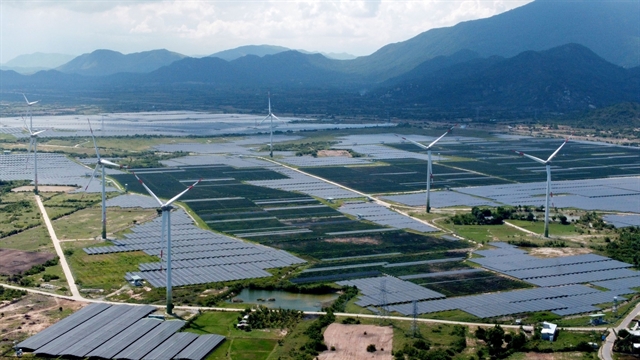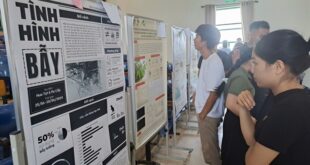
|
| A wind farm in Ninh Thuận Province. Việt Nam aims to raise the share of renewable energy to 62 per cent in the energy mix by 2050. VNA/VNS Photo Huy Hùng |
HÀ NỘI — Việt Nam aims to increase the share of renewable energy in the primary energy supply to around 20 per cent in 2030 and around 85 per cent in 2050.
That was the message from Trần Hồng Thái, Deputy Minister of the Ministry of Science and Technology, at yesterday’s 1st Asia Meeting on Environment and Electrical Engineering.
Thái said Việt Nam was pressing ahead with the phase-in of renewable energy and had launched many programmes, including the national “Researching and Developing Energy Technologies Programme” which is aimed at facilitating investment in green energy and smart grids.
He also said the ministry had recently submitted a legal draft to the Prime Minister for approval, which involves the decommissioning of low-efficiency equipment. The draft was green in that it had a provision for low-efficiency gas- and coal-powered generators.
Guido Hildner, German Ambassador to Việt Nam, said Germany was providing more than 1 billion euros for cooperation projects in Việt Nam, most of which focused on green energy transition.
“We are supporting Việt Nam to read existing job profiles and develop new ones with green skills. Each year, 35,000 trainees are benefiting directly from our cooperation”, said the ambassador.
He added that in the next two years, Germany would provide another 61 million euros for projects in three areas – forestry, energy, and vocational training.
Đặng Bằng Việt, Deputy Director of Science, Technology & Energy Department, Vietnam Electricity, said the National Power Development Plan VIII (PDP VIII) had set the targets for energy transition in Việt Nam in the next decades.
From 2023 to 2050, under the plan, the share of renewable energy in the energy mix is expected to increase from 26 to 62 per cent. Hydropower would move in the opposite direction, from 28 to 6 per cent. The same goes for coal-derived power, which would be phased out during the period.
Meanwhile, gas-derived power is projected to increase from 11 per cent in 2023 to 25 per cent in 2030, then decrease gradually to 8 per cent by 2050.
Khanh Duc Hoang, a representative from the Institute of Energy, said coal-derived power would be completely phased out by 2050. Gas-derived power, meanwhile, was expected to become the core part of the energy mix by 2030 but would be gradually superseded by hydrogen by 2050.
Solar power is projected to hit 189 GW by the date under PDP VIII whereas wind power would contribute 30 GW in 2030 and 170 GW in 2050 to the national power output.
Nguyễn Quang Minh, Director of Power Market Development Research and Training Center, said renewable energy would become mainstream in Việt Nam in the long term but it would be not the case in the short- and medium-term because traditional energy still takes a large share of the pie.
Of the 271.1 TWh of electricity generated in 2022, 38 per cent came from coal, 30 per cent from hydropower, 11 per cent from gas & oil, 10 per cent from solar farms, 3.3 per cent from wind farms, 6.7 per cent from small hydro, and 1.2 per cent from imports. — VNS
- Reduce Hair Loss with PURA D’OR Gold Label Shampoo
- Castor Oil Has Made a “Huge” Difference With Hair and Brow Growth
- Excessive hair loss in men: Signs of illness that cannot be subjective
- Dịch Vụ SEO Website ở Los Angeles, CA: đưa trang web doanh nghiệp bạn lên top Google
- Nails Salon Sierra Madre
 VnExpress News The News Gateway of Vietnam
VnExpress News The News Gateway of Vietnam





